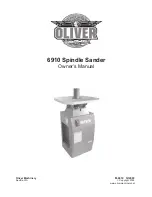
-30-
Model G1066R/Z/G1079R (Mfd. Since 02/11)
The general rule of thumb is to sand a workpiece
with progressively higher grit numbers, with no
one grit increase of more than 50. Avoid skipping
grits; the larger the grit increase, the harder it will
be to remove the scratches from the previous grit.
The Model G1066R/G1066Z/G1079R allows you
to place a different grit sandpaper on each drum.
The front drum should have a coarser grit than
the rear. Usually this translates into combinations
of successive group types. A common selection
for stock that is planed before being sanded is a
100/150 grit combination.
Ultimately, the type of wood you use and your
stage of finish will determine the best grit types to
install on your sander.
Overloading the motor or pushing the sander to
failure weakens the electrical system. Repeatedly
doing so is abuse to the machine that will cause
motor, capacitor, or circuit breaker damage, which
is not covered under warranty.
Sanding Tips
•
When sanding workpieces with irregular sur-
faces, such as cabinet doors, take very light
sanding passes to prevent gouges. When
the drum moves from sanding a wide surface
to sanding a narrow surface, the load on
the motor will be reduced, and the drum will
speed up, causing a gouge.
•
DO NOT edge sand boards. This can cause
boards to kickback, causing serious personal
injury. Edge sanding boards also can cause
damage to the conveyor belt and sandpaper.
•
When sanding workpieces with a bow or
crown, place the high point up (prevents the
workpiece from rocking) and take very light
passes.
•
Feed the workpiece at an angle to maxi-
mize stock removal and sandpaper effec-
tiveness, but feed the workpiece straight to
reduce sandpaper grit scratches for the finish
passes.
Figure 67. Example of using D3003 PRO-STIK®
Cleaning Pad to clean sandpaper.
To clean sandpaper rolls:
1. Set table to thickness of cleaning pad.
2. Run pad through sander two or three times,
as shown in
Figure 67. DO NOT take too
deep of a cut—the sandpaper should barely
touch cleaning pad!
• Replace the sandpaper with a higher grit to
achieve a finer finish.
• Raise the table with a maximum of
1
/
4
turn of
the height handle until the workpiece is the
desired thickness.
•
Reduce snipe when sanding more than one
board of the same thickness by feeding them
into the sander with the front end of the sec-
ond board touching the back end of the first
board.
•
Feed boards into the sander at different
points on the conveyor to maximize sand-
paper life and prevent uneven conveyor belt
wear.
•
DO NOT sand boards less than 9" long, 2"
wide, and
1
⁄
8
" thick (G1066R/G1066Z) or
1
⁄
4
"
thick (G1079R) to prevent damage to the
workpiece and the drum sander.
•
Extend sandpaper life by regularly using a
PRO-STICK® sanding pad (
Page 35).
Clean Sandpaper
















































